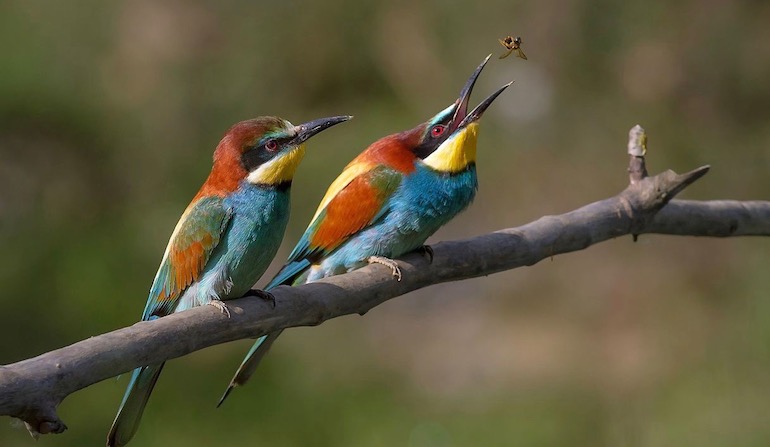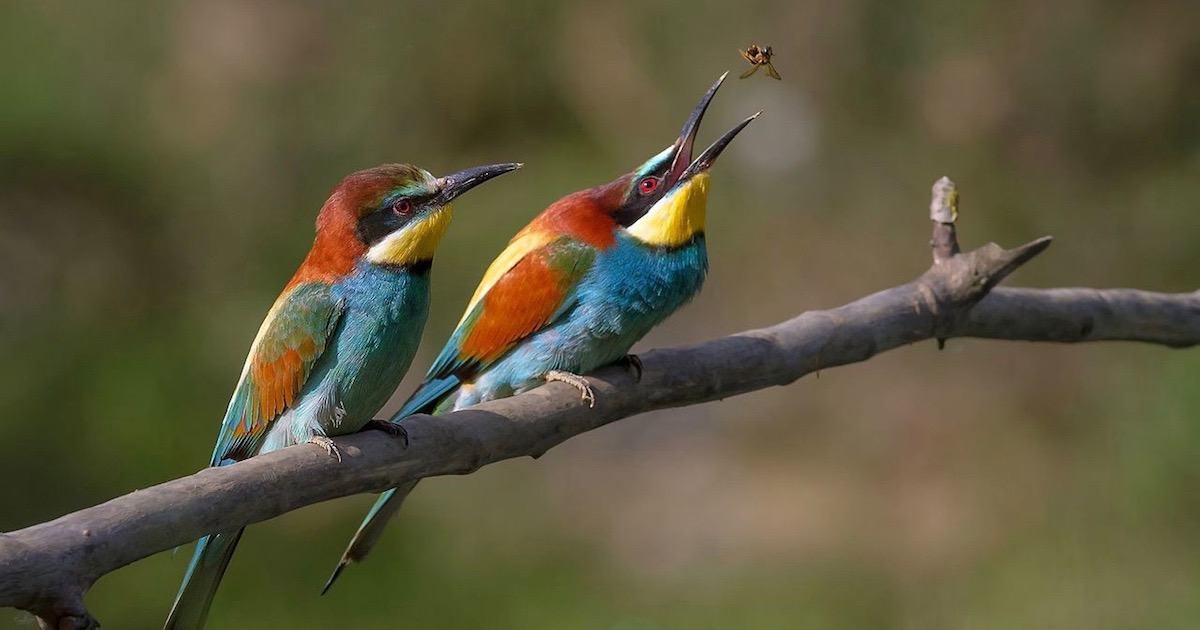 Intelligent Design
Intelligent Design
 Life Sciences
Life Sciences
Migrating Birds Can Find Their Flocks After Many Miles and Days Apart


Carsten Egevang’s study of Arctic terns, highlighted in the Illustra Media documentary Flight: The Genius of Birds, stunned the ornithological world. It was the first time geolocators logged the exact routes of the world travelers, whose annual tour takes them from pole to pole. As geolocators (also called loggers) improve, more species can be studied, increasing our knowledge of migratory behavior. Now, for the first time, a new flight trace shows surprising social interactions en route for a bird that migrates between Europe and Africa.
The European bee-eater (Merops apiaster) is a flashy bird adorned in brilliant shades of rusty red, orange, yellow, and cyan with black highlights on the face. Males and females are similarly colored. Weighing just 2 ounces at a length of 10 to 11 inches, this gregarious bird with a cheerful song covers a lot of territory, looking for bees, wasps, dragonflies, and other insects to eat. Each bird can consume 250 bees a day, but this causes little impact on bee populations (less than 1 percent, according to Wikipedia). The birds catch their prey in flight, but remove the stingers first by banging the insects against hard surfaces before gulping them down.
From Germany to Angola
The migration of M. apiaster takes it between Germany in summer and Angola in winter, a distance of 14,000 km (8,700 miles). This species migrates in small flocks usually ranging from 5 to 39 individuals. But without being able to follow a flock with ultralight aircraft, it is “it has previously been impossible to monitor spatiotemporal group dynamics in small migrating birds.”
Researchers from the Swiss Ornithological Institute, reporting in Current Biology, outfitted 77 Merops birds in 2015, and 92 more in 2016 with loggers. The instruments recorded ambient light for geolocation and atmospheric pressure for altitude. Ten birds were recovered in 2016, and 19 in 2017. The scientists wanted to investigate the following question:
From zebras to monarch butterflies, migratory species undertake some of the most extreme feats of endurance known in the animal kingdom. With the advent of novel tracking technologies, we are gradually completing the picture of where and when they travel. However, without being able to directly observe migration, we have very little knowledge of who might migrate with whom. [Emphasis added.]
From the data, the scientists were able to piece together the routes of each individual, and infer social interactions within the flock. To the researchers’ surprise, some birds could separate from the main flock in small groups, fly thousands of miles apart on another route, and then re-join the main flock up to 5 days later, even though the sub-flocks probably encountered different environmental conditions along the way.
We present the first evidence of a migratory bird flying together with non-kin of different ages and sexes at all stages of the life cycle. In fact, 49% stay together throughout the annual cycle, never separating longer than 5 days at a time despite the ∼14,000-km journey. Of those that separated for longer, 89% reunited within less than a month with individuals they had previously spent time with, having flown up to 5,000 km apart. These birds were not only using the same non-breeding sites, but also displayed coordinated foraging behaviors — these are unlikely to result from chance encounters in response to the same environmental conditions alone. Better understanding of migratory group dynamics, using the presented methods, could help improve our understanding of collective decision making during large-scale movements.
Functional Advantages
The authors speculated about functional advantages for this divide-and-conquer strategy that they call “fission-fusion” events, but did not expect to see unrelated birds cooperating so well.
In conclusion, we find that birds from the same colony do not always follow the same migratory routes but will in fact join with birds from nearby colonies post-breeding to form groups that migrate together. Groups are generally stable during migration. However, if groups separate, they can reunite in the non-breeding grounds to form dynamic groups that repeatedly forage together, sometimes separating for 1–5 days at a time before migrating back to the breeding grounds together. Most surprisingly, these groups showed no age or sex structure and consisted of non-kin. Our research is the first to show such behavior between migratory non-breeding non-kin bird groups, displaying rare spatiotemporal group dynamics more often observed in mammals.
The wonder of this behavior can be appreciated by reversing roles. Imagine the birds running an experiment on humans. They remove all smartphones and electronic devices, outfit them with loggers the people can’t read, and send them through uncharted territory in Africa in small groups of mixed sex and age who don’t know each other, telling them to meet in Germany. Wouldn’t the birds be flabbergasted to watch small groups split off from the main group, hike for a thousand miles on a different route without communication, and then re-join the main group a week later? Even if the humans used ultralight aircraft, it would be astonishing to see them find one another.
It’s not like the terrain has some bottleneck that forces the birds toward a particular narrow flight corridor. Somehow, these birds show a degree of social coordination only previously seen in mammals.
Fission-fusion can occur without individuals being able to “recognize” each other per se. The same individuals could encounter each other again and again at the same site as a result of migratory connectivity, simply because it is the only one available to them at a particular period. Under such circumstances, resource bottlenecks are likely driving group fusion, not social relationships. On the other hand, where resources occur broadly over a large area, animals must coordinate decisions to fuse into a long-term group — especially if they regularly fissure and must find each other again. Only species with high social cognition, such as elephants, dolphins, and bats, have been found to form long-term social bonds by coordinating decisions, despite separations imposed by migration. In birds, long-term social bonds, despite fission-fusion dynamics, have been observed between non-migratory non-kin, migratory kin, or migratory bonded pairs. Long-term social bonds, despite fission-fusion dynamics, are poorly understood in non-kin migratory birds.
Group Formation
What they’re saying is that unrelated birds that don’t migrate are known to form social bonds, and mating pairs can be expected to cooperate during migration. But why would unrelated birds of mixed sex and age do this? There are advantages to cooperation: “Group formation is pivotal in allowing individuals to interact, transfer information, and adapt to changing conditions,” they say. But it also comes with risks:
Migratory species are notable for their propensity to aggregate in large numbers. The stability of migratory groups over time can be important in determining survival, navigational accuracy, migratory speed, transfer of information, and new migratory behaviors. However, migrating with others is not without risk, as it can increase both disease prevalence and resource competition. Group size typically fluctuates over time and space, with individuals coming together and separating; hereafter termed “fission-fusion dynamics”) as they trade off the different benefits and costs of cooperation. Indeed, resource patches are distant, seasonal, and often unpredictable. One slow individual could, for instance, force the entire group to slow down and miss peaks in resource availability, creating conflict. Groups can therefore either compromise to remain together or spilt into subgroups, for example, of different migratory speeds.
These birds appear to have reached an optimal trade-off between benefits and risks. How could such complex behavior arise by mutation and selection? It seems a challenge too daunting for neo-Darwinism. Maybe that’s why the researchers don’t speculate about evolution.
As wonderful as the observed group dynamics have been shown to be, there are other wonders even greater. Try to build a robot that can fly and power itself by capturing and consuming bees. While you’re at it, make it beautiful to look at and able to sing a beautiful song. Fit all that capability into two ounces, and give it software to find a target 9,000 miles away employing optimal group dynamics. Then endow it with the ability to make copies of itself. If you succeeded at all this, would you not be offended to hear some people say it “emerged” by chance?
Photo: European bee-eaters, note the bee which is about to meet its fate, by Pierre Dalous [CC BY-SA 3.0], from Wikimedia Commons.
